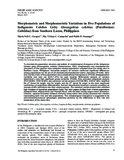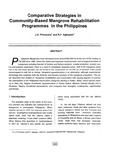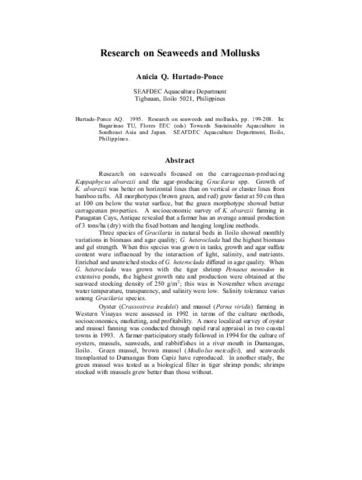| dc.contributor.author | Cuvin-Aralar, Maria Lourdes | |
| dc.contributor.author | Fastner, Jutta | |
| dc.contributor.author | Focken, Ulfert | |
| dc.contributor.author | Becker, Klaus | |
| dc.contributor.author | Aralar, Emiliano V. | |
| dc.date.accessioned | 2013-09-07T15:12:14Z | |
| dc.date.available | 2013-09-07T15:12:14Z | |
| dc.date.issued | 2002 | |
| dc.identifier.citation | Cuvin-Aralar, M. L., Fastner, J., Focken, U., Becker, K., & Aralar, E. V. (2002). Microcystins in natural blooms and laboratory cultured Microcystis aeruginosa from Laguna de Bay, Philippines. Systematic and Applied Microbiology, 25(2), 179–182. | en |
| dc.identifier.issn | 0723-2020 | |
| dc.identifier.uri | http://hdl.handle.net/10862/1619 | |
| dc.description.abstract | Laguna de Bay, the largest freshwater lake in the Philippines, experiences periodic blooms of the cyanobacteria Microcystis aeruginosa. Blooms of these cyanobacteria in 1996, 1998 and 1999 were sampled. HPLC and MALDI-TOF mass spectrometry were used to analyze for microcystins. A total of 16 structural variants of the toxin were isolated from the samples with microcystin LR (MC-LR) as the most abundant variant in the samples from 1996 and 1999 making up 77 to 85% of the total, respectively. MC-RR was the dominant variant in the 1998 bloom making up 38%. The samples from 1996 had the highest total toxin concentration (4049 µg g-1) followed by those from 1998 (1577 µg g-1) and 1999 (649 µg g-1). A strain of M. aeruginosa previously isolated from the lake was also cultured in the laboratory under different nitrogen concentrations (1, 3 and 6 mg L-1) and elevated phosphorus concentration (0.5 mg L-1) to determine the influence of these factors on toxin production. A total of 9 different structural variants of microcystin were isolated from the laboratory cultures with MC-LR consisting more than 75% of the total in all treatments. No significant differences in the total toxin concentration as well as the % distribution of the different variants among treatments were observed. However, the strain of M. aeruginosa cultured in the laboratory had from 3 to 20 times higher total microcystin than those harvested from the lake. | en |
| dc.description.sponsorship | This study was part of the EU-funded project "Laguna de Bay, Philippines: An Ecosystem Approach for Sustainable Management" under contract CT 94-0334. Additional funds were provided by SEAFDEC/AQD under Project FS-03-F97B. The senior author was supported by a grant from the Deutscher Akademischer Austauschdienst (DAAD). Dr. S. F. Baldia provided the M. aeruginosa isolates and Mr. E Reyes assisted in the culture and field collection of the samples. | en |
| dc.language.iso | en | en |
| dc.publisher | Urban & Fischer Verlag | en |
| dc.subject | Microcystins | en |
| dc.subject | Laguna de Bay, Philippines | en |
| dc.subject | Microcystis aeruginosa | en |
| dc.subject | Philippines | en |
| dc.subject | bacterial toxins | en |
| dc.subject | Marine toxins | en |
| dc.title | Microcystins in natural blooms and laboratory cultured Microcystis aeruginosa from Laguna de Bay, Philippines. | en |
| dc.type | Article | en |
| dc.citation.volume | 25 | |
| dc.citation.issue | 2 | |
| dc.citation.spage | 179 | |
| dc.citation.epage | 182 | |
| dc.citation.journalTitle | Systematic and Applied Microbiology | en |
| dc.subject.asfa | nitrogen | en |
| dc.subject.asfa | phosphorus | en |
| dc.subject.asfa | peptides | en |
| dc.identifier.doi | 10.1078/0723-2020-00102 | |



